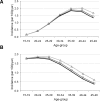Estimating incidence from prevalence in generalised HIV epidemics: methods and validation
- PMID: 18590346
- PMCID: PMC2288620
- DOI: 10.1371/journal.pmed.0050080
Estimating incidence from prevalence in generalised HIV epidemics: methods and validation
Abstract
Background: HIV surveillance of generalised epidemics in Africa primarily relies on prevalence at antenatal clinics, but estimates of incidence in the general population would be more useful. Repeated cross-sectional measures of HIV prevalence are now becoming available for general populations in many countries, and we aim to develop and validate methods that use these data to estimate HIV incidence.
Methods and findings: Two methods were developed that decompose observed changes in prevalence between two serosurveys into the contributions of new infections and mortality. Method 1 uses cohort mortality rates, and method 2 uses information on survival after infection. The performance of these two methods was assessed using simulated data from a mathematical model and actual data from three community-based cohort studies in Africa. Comparison with simulated data indicated that these methods can accurately estimates incidence rates and changes in incidence in a variety of epidemic conditions. Method 1 is simple to implement but relies on locally appropriate mortality data, whilst method 2 can make use of the same survival distribution in a wide range of scenarios. The estimates from both methods are within the 95% confidence intervals of almost all actual measurements of HIV incidence in adults and young people, and the patterns of incidence over age are correctly captured.
Conclusions: It is possible to estimate incidence from cross-sectional prevalence data with sufficient accuracy to monitor the HIV epidemic. Although these methods will theoretically work in any context, we have able to test them only in southern and eastern Africa, where HIV epidemics are mature and generalised. The choice of method will depend on the local availability of HIV mortality data.
Conflict of interest statement
Figures

 is the fraction of infected individuals that survive between surveys;
is the fraction of infected individuals that survive between surveys;  is mortality rate of infected individuals in the cohort;
is mortality rate of infected individuals in the cohort;  is the rate of HIV incidence in the cohort. N and H are not used required to use the methods but do appear in the mathematical derivation. (B) Cross-sectional incidence (
is the rate of HIV incidence in the cohort. N and H are not used required to use the methods but do appear in the mathematical derivation. (B) Cross-sectional incidence ( ). (C) Contributions to cross-sectional incidence estimate from incidence in two cohorts (
). (C) Contributions to cross-sectional incidence estimate from incidence in two cohorts ( and
and  ). For details see main text and Text S1.
). For details see main text and Text S1.
 ) using data on survival after infection, it is necessary to approximate the composition of the infected population in that cohort with respect to time since infection. Thus, it is necessary to consider the previous exposure of that cohort to incidence (indicated by the grey lines and text). When the intersurvey period is the same as the width of the age groups (T = r), and the pattern of incidence is constant, the previous experience of the cohorts will be reflected in the experience of younger cohorts (i.e., cohorts 0, 1, and 2).
) using data on survival after infection, it is necessary to approximate the composition of the infected population in that cohort with respect to time since infection. Thus, it is necessary to consider the previous exposure of that cohort to incidence (indicated by the grey lines and text). When the intersurvey period is the same as the width of the age groups (T = r), and the pattern of incidence is constant, the previous experience of the cohorts will be reflected in the experience of younger cohorts (i.e., cohorts 0, 1, and 2).



References
-
- Joint United Nations Programme on HIV/AIDS (UNAIDS) 2006 Report on the global AIDS epidemic. Geneva: United Nations; 2006. Available: http://www.unaids.org/en/HIV_data/2006GlobalReport/default.asp. Accessed 8 March 2008.
-
- UNAIDS/WHO Working Group on Global HIV/AIDS and STI Surveillance. Guidelines for second generation HIV surveillance for HIV: The next decade (2000) Geneva: WHO; 2000. WHO/CDS/EDC/2000.05. Available: http://www.who.int/hiv/pub/surveillance/pub3/en/index.html. Accessed 8 March 2008.
-
- UNAIDS, Wellcome Trust Centre for the Epidemiology of Infectious Diseases. UNAIDS Best Practice Collection. Geneva: UNAIDS; 1999. Trends in HIV incidence and prevalence: Natural course of the epidemic or results of behavioural change. UNAIDS 99.12e. Available: http://www.who.int/hiv/strategic/surveillance/pubincprev/en/index.html. Accessed 8 March 2008.
Publication types
MeSH terms
Grants and funding
LinkOut - more resources
Full Text Sources
Medical

